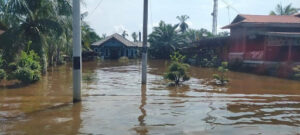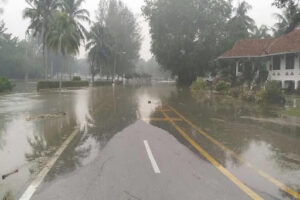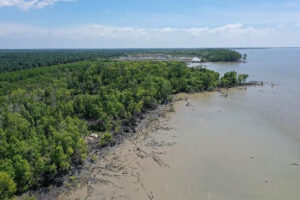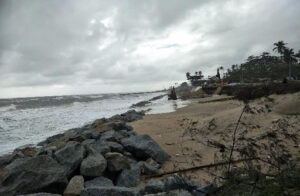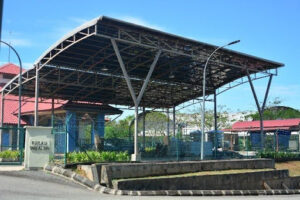The Climate Crisis
Malaysia’s Battle Against a Heating Planet
by Ir. Ts. Ahmad Hadi bin Mohamed Rashidi,
Nurul Huda binti Md Adnan
& Dr. Zuhaili Idham
Climate change is a worldwide phenomenon mostly driven by human activities and natural factors that alter the Earth’s climate system. Greenhouse gas (GHS) emissions into the atmosphere from burning fossil fuels, deforestation, agriculture, industry processes and waste management are the primary causes of the change brought on by human activity. These emissions trap heat, making the earth warmer. According to the Sixth Assessment Report of the Intergovernmental Panel on Climate Change (IPCC-AR6), these activities have played a major role in the last decade’s highest levels of greenhouse gas emissions in human history. On the other hand, recent changes are significantly less influenced by natural factors like solar activity, oceanic and orbital changes, and volcanic eruptions.
According to the IPCC-AR6 Report, temperatures have risen by 1.1°C since the pre-industrial era and are predicted to increase by 1.5°C over the next 20 years. The average global temperature is predicted to rise by more than 2 °C between 2040 and 2060 if no mitigation measures are implemented. Global warming may have several detrimental effects on the environment, ecosystem, human health, and socioeconomic system. In terms of the hydro-environment, climate change would have caused extreme weather events that alter the amount and intensity of rainfall, which would have raised the likelihood of future floods or droughts. From an oceanic standpoint, sea level rise brought on by ice melting and seawater thermal expansion would have led to beach erosion, coastal flooding, and inundation of low-lying areas.
National Water Research Institute of Malaysia (NAHRIM) under the Ministry of Energy Transition and Water Transformation (PETRA) is responsible for conducting national research and development activities initiatives pertaining to the effects of climate change on the water sector. The study by NAHRIM found that by 2100, Malaysia will experience a temperature increase of 1.7°C to 2.1°C, a rainfall increase of 9% to 25%, and a sea level rise of up to 0.73 meters. The intensity of extreme rainfall is projected to increase by 16% to 20% in Peninsular Malaysia and 21% to 30% in Sabah and Sarawak. Flooded areas are expected to increase by up to 18.2% in Peninsular Malaysia, 5.2% in Sabah, and 3.5% in Sarawak. These findings highlight the need for improved water management and climate resilience strategies in Malaysia. Want to dive deeper into the research? Check out the detailed findings here: https://unfccc.int/documents/638313
Malaysia is stepping up its fight against climate change with innovative tools and forward-thinking strategies. One such breakthrough is the NAHRIM-Hydroclimate Data Analysis Accelerator (N-HyDAA), a hydroclimate projection system launched in 2016. Powered by big data analytics (BDA), N-HyDAA uses hydroclimate modeling to predict future rainfall patterns and identify areas at risk of flooding as climate conditions shift. Unlike short-term weather forecasting systems such as those from MET Malaysia, N-HyDAA provides long-term projections extending up to the year 2100. Its key modules analyze rainfall intensity, flood and drought factors, river flow impacts, and Water Stress Index projections, making it an invaluable tool for proactive planning.
Longer dry spells caused by fewer rainfall events lead to higher evaporation rates. This means rivers, lakes, and reservoirs have lower water levels, which makes pollutants more concentrated. As a result, water quality deteriorates, impacting aquatic life and making water less suitable for human use. To tackle these problems, Malaysia is adopting several strategies like Integrated Water Resource Management (IWRM), water rationing, and developing alternative water sources. Some innovative solutions to store water more efficiently include off-river storage systems (TAPS/ORS), coastal reservoirs, underground dams (UGD), rainwater harvesting systems (SPAH/RWH), and reclaimed water from treated sewage for industrial or non-drinking uses. Smart and innovative agricultural practices also help farmers adapt to unpredictable weather patterns and changing rainfall.
Reducing flood risks is another priority. This involves incorporating climate change factors into flood risk assessments and protection projects. Building climate-resilient infrastructure for water, energy, transportation, and communication networks helps protect livelihoods and minimize economic losses. Nature-based solutions, such as restoring wetlands, play a key role by absorbing excess rainwater and releasing it slowly, reducing floods while benefiting ecosystems. Improved weather forecasting and early warning systems tailored to future climate conditions are also essential.
Malaysia’s rich biodiversity is under threat from climate change. Rising temperatures, changing water availability, and saltwater intrusion are degrading critical habitats like wetlands and mangroves. Wildlife such as the Malayan tiger, Asian elephant, and various amphibians rely on freshwater sources and are particularly vulnerable to heat waves, which cause stress, reduce reproduction, and force changes in habitat use. If these threats remain unchecked, some species may face extinction. To protect these ecosystems, Malaysia has initiatives like the Central Forest Spine (CFS) project, the Heart of Borneo (HoB) initiative, and plans to expand protected land and water areas. Mangrove conservation and restoration projects help coastal communities become more resilient to sea-level rise and extreme weather while managing watershed flow.
Malaysia is strengthening climate adaptation through Nationally Determined Contribution (NDC 3.0), focusing on water, health, agriculture, and infrastructure. Collaboration across sectors ensures effective implementation, supported by NAHRIM’s research and assessments. Joint action is crucial for a sustainable future. For more details on research and strategies from NAHRIM, visit www.nahrim.gov.my.
Ir. Ts. Ahmad Hadi bin Mohamed Rashidi is a research officer at Corporate Management Division, NAHRIM. His RDCI works focuses on coastal engineering and impacts of sea level rise. His product innovations have received multiple gold medal awards in various competitions. Completed MSc. Maritime Civil Engineering, University of Liverpool, UK (2010) and BEng. Civil Engineering, University Teknologi Malaysia (2004).
Nurul Huda binti Md Adnan is a research officer at the Water Resource and Climate Change Research Centre, NAHRIM. Actively involved in numerous national-level initiatives, including contributions in reports to UNFCCC and development of climate change-related publications, guidelines and systems. Completed MEng. Civil-Environmental Management, Universiti Teknologi Malaysia (2009), is pursuing a PhD focused on climate resilience and disaster risk reduction in urban areas.
